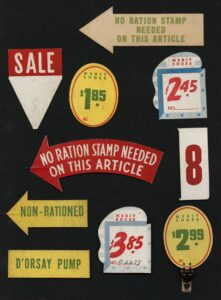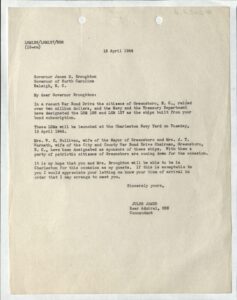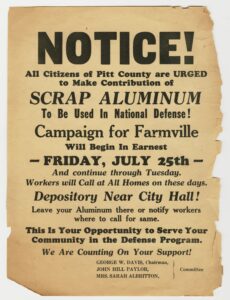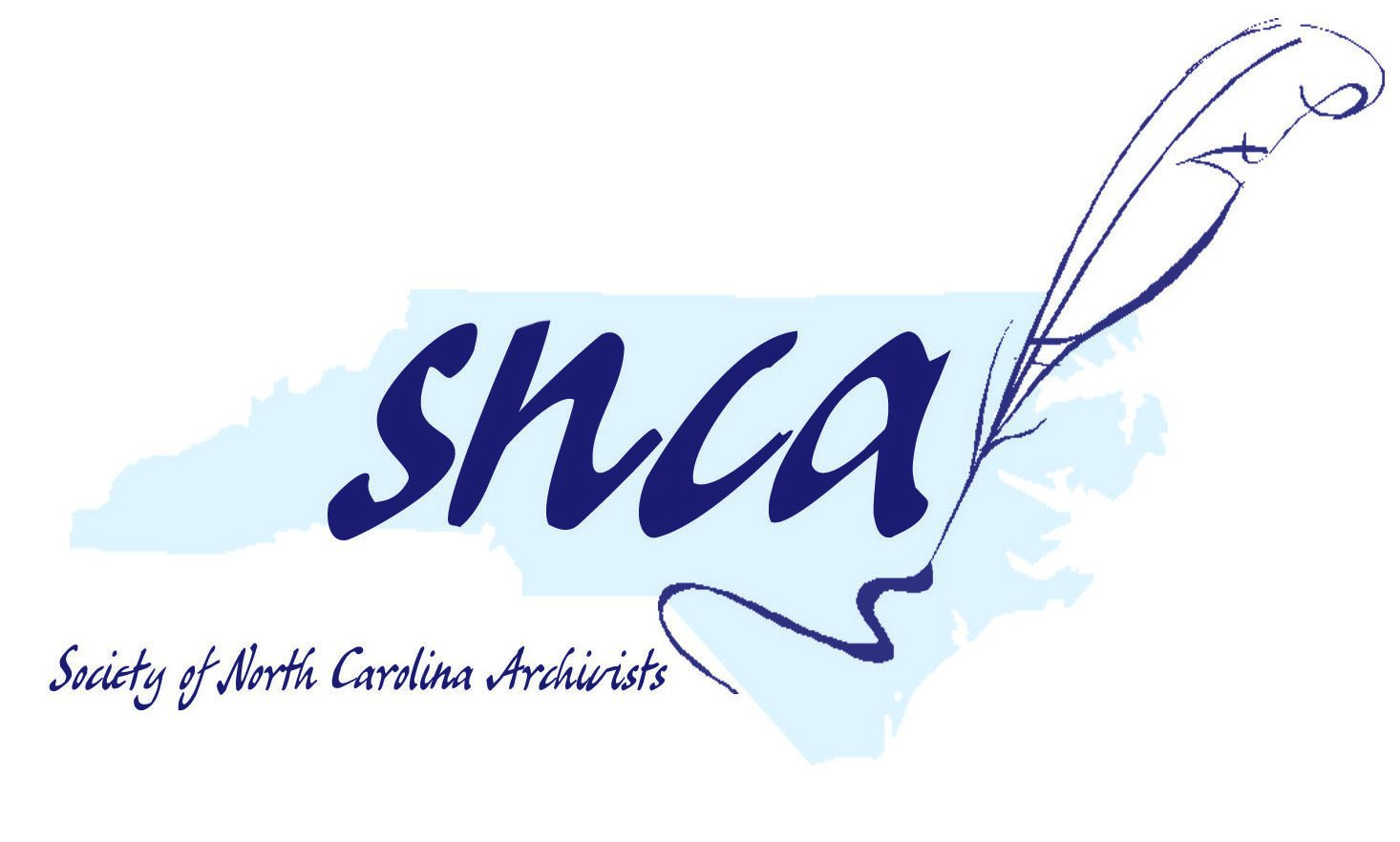Over the next year, in commemoration of the 80th anniversary of the end of World War II, Joyner Library Special Collections will be highlighting items from the East Carolina Manuscripts Collection that relate to the conflict and the individuals who served. See also the 1st and 2nd and 3rd and 4th and 5th and 6th and 7th posts. The following post was contributed by Patrick Cash.
World War II brought profound changes to American life, especially on the home front. The war effort required vast amounts of resources—both physical and financial—which posed a significant challenge for a nation mobilizing to fight in distant theaters across Europe and the Pacific. To address these needs, the federal government introduced two key programs: rationing and war bonds. These initiatives not only sustained the military effort but also fostered a sense of shared responsibility among citizens.
Rationing: Managing Limited Resources
As the United States entered World War II after the attack on Pearl Harbor in 1941, it quickly became apparent that the country would need to control consumption on the home front to ensure adequate supplies for the military. Resources like food, rubber, gasoline, and metals were all critical to war production. To meet these needs, the Office of Price Administration (OPA) instituted rationing, a program designed to limit consumption and prevent shortages or inflation, in May 1942. The goal was to ensure fair distribution, reduce waste, and channel as many resources as possible toward the war effort.

Ration books such as this one allowed individuals to purchase limited quantities of certain items. Lester and Agnes Parker Collection (#1005), East Carolina Manuscript Collection, J. Y. Joyner Library, East Carolina University, Greenville, North Carolina, USA.
How Rationing Worked
Under rationing, specific goods, such as sugar, were limited or only available through ration stamps. Each household received a ration book filled with stamps that allowed them to buy limited quantities of certain items. Meats, dairy products, and canned goods were among the foods rationed, as these items were essential to feeding troops overseas. Gasoline, tires, and rubber were also tightly regulated by the government as these resources were crucial to military vehicles and machinery.
A color-coded system organized ration stamps by category: blue for processed foods, red for meats and fats, and green for vegetables. Shoppers presented the stamps to purchase their allotted share, forcing families to carefully plan meals around available items. Many Americans turned to “Victory Gardens” to supplement their rations, growing vegetables in backyard plots or community gardens to ease the strain on the food supply.
While rationing meant personal sacrifices, it also strengthened a sense of purpose. Families, friends, and neighbors adjusted to new norms and lifestyles, supporting each other with tips on making the most of rationed goods and exchanging recipes. The restrictions transformed everyday routines, but the knowledge that sacrifices would benefit soldiers and allied countries made these hardships feel meaningful.

Signs like these helped customers identify goods that could be purchased without using ration stamps. Images from, Jesse Rountree Moye Papers (#1111), East Carolina Manuscript Collection, J. Y. Joyner Library, East Carolina University, Greenville, North Carolina, USA.
The Impact on the Economy and Society
Rationing also helped curb inflation by keeping consumer prices stable. With limited quantities available, the government attempted to control supply and demand to avoid drastic price spikes. However, rationing presented challenges, leading to a black market for items like gasoline and meat. Despite these illicit activities, most Americans followed rationing guidelines, understanding that conservation at home was vital for success abroad.
Rationing influenced various social dynamics, promoting thriftiness and resourcefulness. Homemakers became creative, finding ways to stretch limited ingredients or substitute non-rationed items. This encouraged a culture of “making do,” with civilians viewing sacrifices as their contribution to the national effort. Rationing taught new life skills that many Americans carried forward, emphasizing resource conservation and collective responsibility.
War Bonds: Funding the Fight
While rationing conserved essential resources, financing the war effort required massive amounts of money. To raise funds, the government issued war bonds, which allowed citizens to lend money to the government with the promise of repayment plus interest after a set period. The sale of war bonds provided a way for Americans to invest in their country’s success and to support their loved ones fighting overseas. In total, over 84 million Americans purchased war bonds, providing $150 billion in financial support for the war.

War bonds were used to fund the war effort. The federal government used the money raised from selling war bonds to pay for military equipment, uniforms, food, and medicine. This letter from the Jules James Papers mentions that a war bond drive in Greensboro, NC funded the construction of a new naval ship. Jules James Papers (#223), East Carolina Manuscript Collection, J. Y. Joyner Library, East Carolina University, Greenville, North Carolina, USA.
War Bond Drives
The government conducted aggressive campaigns to encourage war bond purchases, often appealing to patriotism and duty. Famous slogans like “Buy a Bond – Beat a Nazi” and “They Give Their Lives—You Lend Your Money” emphasized the importance of personal contributions. War bond drives became momentous events, often led by celebrities and community leaders. Movie stars, athletes, and politicians took to the airwaves and visited cities, urging people to buy bonds to secure victory.
Schools, factories, and community organizations set up bond competitions to inspire more people to buy. Even children were involved, encouraged to purchase ten-cent stamps that they could redeem for bonds once they saved enough. These drives, promoted through posters, radio broadcasts, and public appearances, created a sense of unity and pride.
Economic and Social Impact
War bonds offered Americans a way to contribute financially while simultaneously investing in the country’s future. Purchasing bonds was not only patriotic but also a prudent financial decision. Bonds accrued interest, allowing citizens to save for postwar prosperity while knowing that their money was helping to buy supplies and equipment for the armed forces.
The psychological impact of war bonds was significant. By purchasing a bond, a person felt directly involved in the nation’s mission, symbolizing shared commitment and sacrifice. It gave everyday citizens a tangible role in the war effort, deepening their emotional connection to the cause. Additionally, bond drives brought communities together and reminded American citizens of their collective resilience and the importance of standing together during a national crisis.
Rationing, War Bonds, and National Unity
Both rationing and war bonds had an overarching effect on American society: they fostered unity and instilled a powerful sense of shared purpose. As families rationed and individuals bought bonds, the lines between the home front and battlefront blurred. The notion of “Total War” meant that everyone contributed, whether they were on the front lines or the factory floor, in fields or at home.
The wartime experience unified Americans across diverse backgrounds, pushing them toward collective goals that transcended individual needs. Through everyday acts of rationing and small financial contributions, citizens recognized that victory relied on the actions of each person, forming an interdependent society.

Community drives, such as this scrap aluminum drive that took place in Farmville, NC, helped Americans back home feel pride in helping the war effort. Image from, Tabitha Marie DeVisconti Papers (#480), East Carolina Manuscript Collection, J. Y. Joyner Library, East Carolina University, Greenville, North Carolina, USA.
Legacy of the Home Front Effort
When the war ended in 1945, the impact of rationing and war bonds left a legacy on American culture. Citizens emerged from the war with a new appreciation for resource management, saving, and collective responsibility. “Victory Gardens” transformed into home gardens, war bond savings funded postwar purchases, and rationing’s lessons in thrift helped Americans adjust to the changes brought by peacetime.
Rationing and war bonds on the home front reflected the power of unified action during World War II. Together, these programs created a powerful model of national mobilization that underscored the importance of civilian involvement in times of crisis. They remind us today of the enduring power of shared sacrifice, even when the battles may not take place on traditional front lines. Through cooperation and commitment, Americans on the home front became as vital to victory as the soldiers who fought overseas, proving that the spirit of unity and resilience is one of the country’s greatest strengths.
